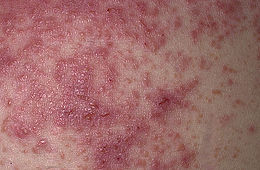Dermatitis Herpetiformis Symptoms
Referencing information from Marietta EV, Camilleri MJ, Castro LA, Krause PK, Pittelkow MR, Murray JA (February 2008). "Transglutaminase autoantibodies in dermatitis herpetiformis and coeliac sprue". J. Invest. Dermatol. 128 (2): 332–5. [email protected]
 Typical rash |
Ever wonder about Dermatitis Herpetiformis Symptoms? Dermatitis herpetiformis is characterized by intensely itchy, chronic papulovesicular eruptions, usually distributed symmetrically on extensor surfaces (buttocks, back of neck, scalp, elbows, knees, back, hairline, groin, or face). The blisters vary in size from very small up to 1 cm across.
The condition is extremely itchy, and the desire to scratch can be overwhelming. This sometimes causes the sufferer to scratch the blisters off before they are examined by a physician. Intense itching or burning sensations are sometimes felt before the blisters appear in a particular area.
Untreated, the severity of DH can vary significantly over time, in response to the amount of gluten ingested.
Dermatitis herpetiformis symptoms typically first appear in the early years of adulthood between 20 and 30 years of age.
Although the first signs and symptoms of dermatitis herpetiformis are intense itching and burning, the first visible signs are the small papules or vesicles that usually look like red bumps or blisters. Sometimes they appear on the face and along the hairline, and, on occasion, on the shoulders, the lower end of the spinal column, and within the mouth[citation needed]. The rash rarely occurs on other mucous membranes, excepting the mouth or lips. The symptoms range in severity from mild to serious, but they are likely to disappear if gluten ingestion is avoided and appropriate treatment is administered.
Dermatitis herpetiformis symptoms are chronic, and they tend to come and go, mostly in short periods of time. Sometimes, these symptoms may be accompanied by symptoms of coeliac disease, commonly including abdominal pain, bloating or loose stool, and fatigue.
The rash caused by dermatitis herpetiformis forms and disappears in three stages. In the first stage, the patient may notice a slight discoloration of the skin at the site where the lesions appear. In the next stage, the skin lesions transform into obvious vesicles and papules that are likely to occur in groups. Healing of the lesions is the last stage of the development of the symptoms, usually characterized by a change in the skin color. This can result in areas of the skin turning darker or lighter than the color of the skin on the rest of the body. Because of the intense itching, patients usually scratch, which can lead to the formation of crusts.
- The Cause of Eczema: What You Weren't Told
- Cercarial Dermatitis: What to Know about Treatment
- Best Treatment for Psoriasis
- Atopic Eczema
- Molluscum Contagiosum Treatment
- Psoriasis Wiki
- Pyotraumatic Dermatitis
- Plaque Psoriasis Treatment
- Hand Dermatitis (Eczema)
- Lichenoid Dermatitis Information
- Neurodermatitis Treatment and Info
- What is a Dermatologist?
- Psoriasis Skin Disease Information
- Infantile Seborrheic Dermatitis
- Venous Stasis Dermatitis Treatment
- Risk Factors of Neurodermatitis
- Occupational Dermatitis: Caused In The Workplace
- What does psoriasis look like?
- Foot Dermatitis Risk Factors
- Petaloid Seborrheic Dermatitis
